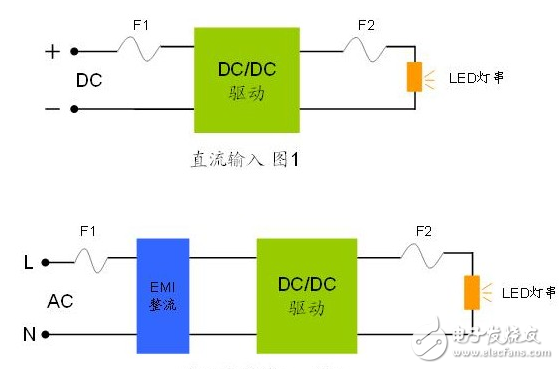LEDs have the characteristics of low power consumption, long life, and environmental protection. After infiltrating large-sized panel backlights from small-sized backlight applications, they are now expanding into general-purpose lighting applications, currently in landscape, architecture, commercial, automotive, The field of mobile lighting and other fields is developing rapidly.
In the face of many application fields of LED lighting, because the market does not form a unified specification, there are a variety of driving solutions, but it is inseparable from the perspective of overcurrent protection, generally based on the input current of the lamp body. It can be divided into two basic types: DC input and grid AC input. The main difference between the two types is whether the drive power has AC to DC modules.

Of course, there are many low-cost solutions such as resistors and RCs in the market. There are no EMI rectification and constant current drive modules. However, since the selection requirements of the primary side fuses are the same as those in Figure 2, they fall into the second type.
There are three main purposes for LED lighting overcurrent protection:
First, the purpose of protecting personal and property safety is generally to increase the protection device for this purpose in applications where the power input voltage is relatively high.
Second, the subsystem is separated from the external system. If the external system is unstable, it will affect the security of the subsystem. On the other hand, the device damage occurs inside the subsystem, such as the short-circuit failure mode of the parallel device, or the internal original due to external factors. The safe insulation level is destroyed, causing the internal circuit to short to ground.
If there is no fuse action to block the external system and no effective measures are taken in time, it will cause the external system's insurance system to act, which will cause the entire power supply system to be interrupted, which will indirectly cause unexpected losses in important places such as hospitals, even There may be casualties, so sometimes you need to add 2 fuses to the power input.
Third, protect important and valuable electronic components or devices. For LED lighting fixtures, the cost of LED bulbs accounts for the majority of the total cost of the fixture. In non-isolated power-driven or non-constant-current-driven circuits, the necessary overcurrent protection is required for the output of the driver.
Due to the different architecture of the power input, there is a big difference in the focus of the choice of overcurrent protection devices:
1. For the selection of DCin fuse of DC input type, special attention should be paid to the temperature reduction factor of the fuse. Since the heat of the high-power LED is relatively large, the temperature inside the LED lamp cup is relatively high. Large fuses will choose a larger current specification.
At the same operating current, the protection capability of the fuse with a large current specification is relatively lower; in addition, the position of the DCin, due to the use of capacitive filtering at the back end, will result in a relatively large startup pulse current.
Therefore, in this part of the selection of fuses need to pay attention to the strict consideration of the pulse conditions, otherwise the wrong option is likely to cause the fuse to be pulsed by the startup pulse, it is difficult to go through many times of switching machine experiments and surge current experiments, it is recommended to use strong pulse resistance product.
2. For the fuse selection of the drive output, pay attention to the fuse temperature reduction factor, and also consider the fuse's fuse speed index. Because the current fluctuation is not large here, in the case of abnormal circuit or component failure, it is required. Quickly cut off the circuit to protect the LED string at the back end. In this position, it is recommended to select a fuse with a fast-break type and a reduced temperature.
In the above two cases, there are more low-voltage fuses available on the market, such as AEM Technology's SolidMatrix? Technical fuses, from 0402 to 1206, current specifications from 0.5 to 30A, with fast break, fast break, high pulse resistance, slow break and many other series, different specifications, different characteristics of the product for engineers to choose.
3. For the ACin position of the AC input LED illumination, especially the LED bulb, both the size of the fuse and the withstand voltage of the fuse need to be considered. However, the fuses currently available on the market that can withstand a wide range of AC voltages are generally relatively large, and the small-capacity fuses with few patches can withstand a voltage of 250 VAC, which is a dilemma for this application.
AEM Technology has introduced the AirMatrixTM AF2 series of chip fuses, which are only 6.1mm*2.5mm*2.2mm. They are small but can withstand 250VAC. They also have high consistency, low internal resistance and high pulse resistance. Will bring engineers and friends a new application experience.
Some engineers and friends believe that the fuse can be used for protection regardless of whether the fuse is used in the positive and negative poles and the neutral wire is broken. Here, share the experience with engineers and friends. The fuse needs to have a potential difference on the ground. The fuse on the ground can also cut off the circuit.
However, after the cutting, the entire lighting appliance and the ground still have a potential difference, and once an internal device short circuit occurs, the circuit is in danger. Therefore, in some countries where sockets can be reversed, such as Germany or China, from a safety point of view, it is necessary to consider adding fuses to LNs of some LED lighting fixtures that can be reversed.
Europe Switch Socket M44 Series
Switch Socket Outlet,3 Gang Socket,Matt Black Sockets,Brushed Chrome Light Switch
Guangdong Jinli Electrical Appliance Co., Ltd , https://www.sokelectric.com